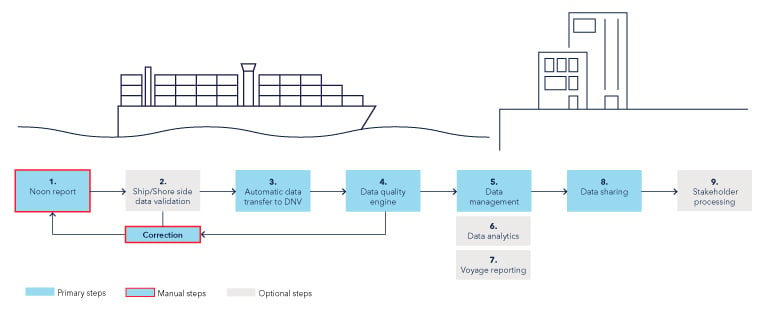Role of data for handling the EU ETS
The introduction of the EU Emissions Trading System (EU ETS) marks a crucial turning point in data management for the maritime industry. While annual reporting sufficed for the MRV and DCS, the EU ETS necessitates daily accuracy in data handling to align with its trading mechanisms. This change represents a substantial challenge, necessitating a collective industry effort to elevate data standards and processes. It’s a critical moment for the industry to adapt swiftly and effectively to meet these heightened requirements.
Below you will also find answers to frequently asked questions (FAQs)
Financial liability and contractual clauses
The EU ETS requires that shipping companies annually report emissions for MRV compliance, purchase EU allowances, and surrender them to the EU’s national authority. This creates a significant financial burden for shipping companies, which they need to pass on to customers. To assist, BIMCO suggests a contract clause for settling costs related to emission allowances. This clause mandates cooperation and data exchange between the owner and charterer in a timely manner throughout the year to comply and calculate the needed allowances for the charter period.Commercial need for non-aggregated, verified data
Previously, annual emissions data was adequate for compliance, but now precise per-voyage data is needed for calculating and settling emission allowances year-round. Daily reporting, verification and corrections are essential, as annual inaccuracies, tolerable for EU MRV compliance, can now lead to significant financial discrepancies due to missing voyages in emissions accounting. Data integrity has become crucial not just for regulatory compliance but also as a vital financial strategy, since inaccuracies directly affect financial outcomes.Accurate emissions reporting starts with high-quality input
High-quality input is key to accurate emissions reporting. Noon reports, filled in by onboard crew, start the process and therefore significantly influence the efficiency and quality of the process. The reported data is verified and checked for missing data and plausibility, such as matching voyage times with miles sailed. Shipping companies must correct any relevant issues found in the process to meet quality standards, ensuring reliable data for compliance and correct EU allowance settlement.
A continuous voyage data verification process relying on the quality of inputs provided
Click image to view it in a higher resolutionDNV’s solution landscape to handle the commercial challenge
DNV offers a comprehensive digital system for handling the challenges of emissions reporting. Our system supports the entire process – from data acquisition to verification, through a reliable network. We enable flexible data transfer, including the integration of your performance management tools with our systems, ensuring real-time data verification, effective data management, and trustworthy insights.
As third-party verifiers, we emphasize our dedication to raising data standards, offering immediate feedback and promoting ongoing improvement. While maintaining our impartiality as verifiers, our goal is to build trust in data, encouraging genuine industry collaboration.
Discover how our Emissions Connect and Integrated Partner Programme can help you benefit from a high-quality data stream.
Frequently asked questions
The following applies only to Operational Vessel Data (OVD) used in commercial or technical processes throughout the year, subjected to voyage leg verification through DNV’s Emissions Connect, and to annual MRV and DCS verification. Specifically, the FAQ deal with questions centred around voyage leg verification and the usage of the data more frequently than annually.
| Answer: |
|---|
Answer:The requirement to settle EU allowances continuously throughout the year means that accurate data needs to be available for shorter periods than the annual aggregation and review under the MRV and DCS. Individual data quality issues therefore have a bigger impact on the overall quality of the reference period. |
| Answer: |
|---|
Answer:In DNV’s experience, most issues stem from data input errors, such as missing or logically incorrect data entries , which can lead to cascading inaccuracies. Often-seen examples include missing fuel consumption, distance or speed reported with an extra zero as the last digit, and the departure port being different from the previous arrival port. |
| Answer: |
|---|
Answer:As data is reported manually, these issues primarily arise from inadequate validation in reporting software, insufficient processes , lack of system support, and reliance on previously acceptable levels of accuracy for annual verifications only. |
| Answer: |
|---|
Answer:Emissions Connect requires a higher level of data precision for each voyage leg compared to the annual aggregation allowed for the MRV and DCS. Minor inaccuracies that were negligible on an annual basis can become significant in voyage leg verifications. |
| Answer: |
|---|
Answer:Daily data reporting is essential for accurate per-leg verification, aligning with the EU MRV requirements to ensure real-time data integrity for compliance and financial settlements. |
| Answer: |
|---|
Answer:Our verification rules are based on the MRV framework. They are stringent to ensure daily data integrity and trust in commercial processes, without adding unnecessary complexity. |
| Answer: |
|---|
Answer:Key practices include establishing a robust data quality feedback loop, where issues identified through regular self-checks are promptly communicated back to the vessel for correction. This, along with validation in reporting software, ongoing training and strong processes, ensures both immediate issue resolution and continuous improvement in data reporting and management. Please refer to DNV’s best practice and recommended practices. Please also refer to DNV’s partner programme. |
| Answer: |
|---|
Answer:As an accredited independent verifier, DNV must maintain impartiality and may not assist in developing monitoring plans or reporting processes, to avoid conflicts of interest. |
| Answer: |
|---|
Answer:Our role as an impartial verifier prohibits us from altering data, ensuring the integrity and objectivity of the verification process. |
| Answer: |
|---|
Answer:Generating statements with subpar data compromises the trust and integrity of the verification process, which is crucial for both regulatory compliance and financial transactions. |
